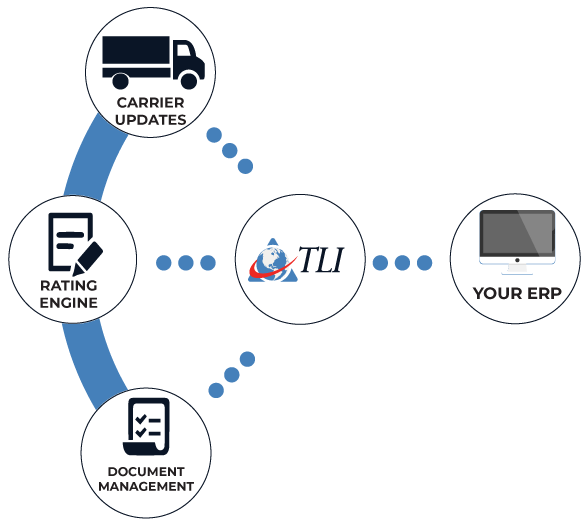Cost-Effective Freight Routing Techniques for Freight Shippers
Freight Routing Strategies for Maximum Cost Efficiency
As a shipper, one of the biggest challenges is finding ways to cut costs and streamline your logistics operations. With freight rates constantly fluctuating and the ever-present need for efficiency, it's crucial to have a solid strategy in place. In this comprehensive guide, we'll explore ten insider shipping tactics that will help you save money and optimize your freight routing like a pro.

How to Reduce Freight Costs
By implementing these insider tactics, you'll not only cut costs but also streamline your shipping operations, enhance tracking visibility, and gain a competitive edge in your industry.
Power of a Preferred Vendor Partnership
While the temptation to shop around for the lowest rates may be strong, working with multiple freight brokers can actually drive up costs in tight capacity markets. By sticking to a primary preferred vendor like Translogistics (TLI) offering managed transportation services, you'll benefit from market-competitive rates, exceptional service, and integrity. Establishing a strong partnership with a reliable provider can pay dividends in the long run. A shipper we partnered with was worried about getting loads covered, sending the shipment out to multiple shipping brokers. As the freight brokerage companies looked for the capacity it was artificially increasing the appearance to the carriers of the loads available per their truck ironically working against the best interest of the shipper. The shipper partnered solely with TLI and received lower rates, better pricing, and more reliable service.

Deploy a Compelling Inbound Procurement Strategy
- Don't overlook the importance of effectively managing your inbound raw material shipments. TLI's two-pronged approach can help you achieve significant savings:
- Vendor Accountability: TLI's Transportation Management System (TMS) allows your vendors to route shipments directly to you using a dynamic routing guide that will properly account for transportation mode and least cost provider, ensuring visibility and control over inbound freight.
- Slippery Dealings: Some vendors offer 'delivered cost' or 'freight baked in' and this could be a wonderful area to negotiate separately to reduce cost on your underlying raw material and benefit from your purchasing team now having total control and tracking visibility. The purchasing team is not manually routing freight through TLI on each inbound order, rather we can role out a vendor portal to your key vendors, or provide them a distribution email unique to your company that will have a freight expert responding with a Bill of Lading, Pallet label and the best cost carrier option.
- Emergency Preparedness: In case of production disruptions, TLI can leverage its air networks to expedite shipments, mitigating potential losses.
Leverage TMS Technology for Shipment Consolidation and Mode Optimization
Consolidation is a strategy widely used in logistics to combine multiple shipments into a single load, thereby reducing the number of individual shipments and minimizing transportation costs. TLI's ViewPoint TMS is equipped with advanced filters and supply chain analytics capabilities that systematically analyze shipping data to identify consolidation opportunities.
By aggregating shipments and optimizing routes, TLI's ViewPoint TMS helps our clients minimize empty space in trucks and trailers, leading to more efficient use of transportation resources. This not only reduces fuel consumption and carbon emissions but also lowers overall shipping costs for our clients.
In addition to identifying consolidation opportunities, TLI's ViewPoint TMS features a powerful mode optimizer that compares rates across different shipping modes, including parcel, less-than-truckload (LTL), and partial truckload (PTL). This functionality ensures that our clients select the most cost-effective mode for each shipment, maximizing savings without compromising on service quality.
Parcel shipping is ideal for small, lightweight packages, while
LTL shipping is suitable for shipments that don't require a
full truckload. On the other hand, PTL and Volume LTL shipping options are a cost-effective option for shipments that are too large for LTL but don't require a full truckload. By comparing rates across these modes, TLI's ViewPoint TMS helps our clients make informed decisions that align with their budget and delivery requirements.

Consider Rail
While traditional trucking may seem like the default choice for many shippers, overlooking the potential of intermodal rail transportation could mean missing out on significant savings. At Translogistics (TLI), we're committed to helping our clients maximize their shipping options and minimize their expenses.
Railroads have the capacity to handle large volumes of freight, making them an ideal choice for shippers with high-volume transportation needs. By tapping into rail freight capacity, businesses can ensure their goods are transported efficiently and cost-effectively.
Rail transportation is inherently more environmentally friendly than traditional trucking, as trains produce fewer emissions per ton-mile of freight transported. By choosing rail freight, businesses can reduce their carbon footprint and contribute to sustainability efforts while saving money!

Implement Freight Invoice Audit and Mitigation Process
Every penny counts, and even small billing errors can add up to significant costs over time. Carriers, despite their best efforts, can sometimes make mistakes when invoicing for freight services, leading to overcharges that impact the bottom line of businesses. However, there's a solution to mitigate these errors and ensure accuracy in billing: implementing a freight invoice audit and mitigation process. At Translogistics (TLI), we leverage cutting-edge TMS technology and dedicated expertise to help our clients identify and rectify billing errors, saving them time, money, and headaches.
The cost of billing errors
Did you know that carriers can make billing mistakes on up to 2.6% of shipments? While this may seem like a small percentage, the financial impact can be substantial, especially for businesses that ship large volumes of freight. Whether it's incorrect rates, inaccurate fuel surcharges, or erroneous accessorial charges, billing errors can quickly accumulate and eat into your profits.
At TLI, we understand the importance of accuracy in freight billing, which is why we've developed an AI-powered freight invoice auditing service to help our clients identify and mitigate billing errors. Our sophisticated algorithms analyze freight invoices with precision, flagging any discrepancies or overcharges for further review. We also have a team of dedicated auditors who work tirelessly to dispute erroneous charges with carriers on your behalf. These freight auditors are experts in freight billing and negotiation, ensuring that you receive fair and accurate invoices for your shipping services.

Recover Freight Claim Settlement Amounts
I once had an executive furious during a quarterly business review because there was a DAMAGED SHIPMENT! "How could you have a shipment damaged?!" He was gently advised by his operations director that they had always had damaged shipments, but now they have a process with TLI where they are recouping those charges because TLI is overseeing the settlement process and mitigating shipping claims. The executive quickly shifted to gratitude and wanted to ensure everyone was educated on how to properly receive and sign PODs on shipments.
Freight claims are an unavoidable reality. Whether it's due to damaged goods, lost shipments, or delays, these incidents can result in financial losses for shippers. However, what many shippers don't realize is that they often leave money on the table by either not filing claims or failing to pursue them to their full potential.
It's a common scenario: a shipment arrives damaged or doesn't arrive at all, and the shipper, overwhelmed by the complexities of the process or simply unaware of their rights, decides to write off the loss. But here's the thing – you don't have to accept these losses as inevitable. With the right approach and assistance, you can recover the settlement amounts you're rightfully owed.
TLI specializes in helping shippers navigate the freight claim process from start to finish, ensuring that they receive the maximum carrier compensation possible for their shipment losses and cargo damage.
Launch a PROPER Transportation RFP
Imagine this: you're a shipper looking to streamline your transportation processes and reduce costs. You've heard about the power of shipping RFPs in soliciting competitive bids from carriers, but where do you even begin? The truth is, many shippers find themselves grappling with the intricacies of RFP formatting, struggling to decipher what information is truly essential to include, nor how to build a proper shipper profile, nor even having a rating engine to run the proposed contracts against your historical data.
Crack the Savings Code
At the heart of every successful transportation RFP lies a wealth of vital information gleaned from historical data. TLI recognizes this fundamental truth and employs it as the cornerstone of their RFP strategy. But what exactly constitutes the core components of an effective RFP template?
- Understanding Your Unique Shipping Profile: One size does not fit all in the world of transportation. Your shipping profile is as unique as your business, encompassing factors such as shipment volume, frequency, and destination diversity. TLI delves deep into your historical data to gain a comprehensive understanding of your shipping profile, ensuring that the RFP is tailor-made to suit your specific needs.
- Accessorial Mix and Freight Class: Accessorials, those additional services beyond standard transportation, can significantly impact your shipping costs. From limited access, liftgate services to inside delivery, understanding your accessorial mix is crucial for accurate pricing. Similarly, freight class plays a pivotal role in determining shipping rates. TLI meticulously analyzes your historical data to ascertain the optimal accessorial mix and freight class for your RFP.
- Density and Cargo Liability Requirements: Density, the relationship between a shipment's weight and volume, directly influences transportation costs. Cargo liability requirements, on the other hand, dictate the level of protection needed for your shipments. TLI delves into your historical data to determine the ideal density mix, PCF, and cargo liability requirements, ensuring that your RFP reflects these crucial factors.
- Real Rating Engine: Separating Substance from Illusion: It's easy for carriers to dazzle with seemingly attractive pricing proposals, but appearances can be deceiving. A 99% discount may sound impressive, but if the base rate is exorbitantly high, it's little more than smoke and mirrors. TLI employs a real rating engine to cut through the noise, evaluating carriers' proposals based on actual historical shipment data to ensure that you receive competitive and meaningful pricing.
It's time to delegate the RFP headache and entrust your shipping optimization journey to the pros. With TLI at the helm, you can rest assured that your
transportation RFP will not only be properly formatted and tailored but also backed by the insights of real shipment data analysis. Too many freight brokers just throw out "We will save you 10%" or carriers submit cryptical non-applicable rating tables, it is time to have a team with the actual experience and technology to get you the shipping profile tailored to your esteemed shipping companies actual needs.
Accurate Freight Cost Tracking and Allocation
For many businesses, the process of tracking and allocating freight costs can be a labyrinthine ordeal. Without the right systems in place, costs can easily get lost in the shuffle, leading to inaccuracies, inefficiencies, and missed opportunities for optimization. Manual data entry, disparate systems, and lack of visibility into cost centers only exacerbate the problem, leaving businesses struggling to gain a clear understanding of their freight expenditure.
TLI recognizes the critical importance of accurate freight cost tracking and allocation and has developed a suite of automated solutions to address this challenge head-on. At the heart of TLI's approach lies automated cost center coding and GL (General Ledger) coding, which streamline the process of assigning costs to the appropriate departments and accounts.
You only improve what you track!
By leveraging advanced algorithms and data integration capabilities, TLI's system automatically assigns cost center codes and GL codes to each freight transaction, ensuring that costs are accurately allocated without the need for manual intervention. This not only eliminates the risk of human error but also provides businesses with real-time visibility into their freight expenditure at a granular level.
TLI's system also incorporates reference number tracking, allowing businesses to track and trace freight costs associated with specific shipments, orders, or projects. This level of granularity enables businesses to perform detailed cost analysis, identify cost drivers, and make informed decisions to optimize their logistics operations.
With accurate freight cost visibility provided by TLI's automated tools, businesses can identify trends, spot anomalies, and uncover opportunities for cost savings and process improvements. Whether it's renegotiating carrier contracts, optimizing shipping routes, or consolidating shipments, TLI's data-driven approach empowers businesses to take proactive measures to enhance efficiency and reduce costs.

Delegate Headaches and Focus on Core Business
From lost shipments to carrier follow-ups, the logistics side of operations can quickly become a headache, diverting valuable time and resources away from your core business activities. Fortunately, there's a solution: partnering with a reliable logistics provider like TLI.
Lost shipments, delayed deliveries, and logistical hiccups can have ripple effects throughout your organization. They can lead to unhappy customers, increased costs, and even damage to your brand reputation. Moreover, the complexities of logistics management require expertise and resources that many businesses simply don't have. By partnering with TLI, you can delegate the headaches of logistics management and refocus your efforts on what matters most—your core business operations.
Integrate TMS Technology with Your ERP System
Transportation Management Systems (TMS) play a pivotal role in optimizing supply chain operations by streamlining transportation processes, reducing costs, and enhancing visibility. However, to unlock the full potential of your logistics management, integration with your Enterprise Resource Planning (ERP) system is essential.
Integrating TMS with your ERP system enables the consolidation of critical data from various sources into centralized dashboards. With real-time visibility into transportation processes, you can track shipments, monitor carrier performance, and identify potential bottlenecks instantly. TLI's TMS enables you to have intuitive dashboards that offer comprehensive insights into your logistics operations, allowing you to make informed decisions and respond swiftly to changing circumstances.

Gone are the days of static, outdated reports that offer limited value. By integrating TMS with your ERP system, you can leverage advanced reporting capabilities to generate customizable reports tailored to your specific needs. Whether it's analyzing freight spend, evaluating carrier performance, or forecasting demand, TLI's TMS empowers you with dynamic reporting tools that provide actionable insights for optimizing your logistics strategy.
How to reduce freight costs:
Optimize Loading / Unloading Times
One often overlooked aspect of shipping costs is detention charges incurred due to delays in loading or unloading at facilities. Carriers typically allow a certain amount of free time for loading and unloading, after which detention charges start accruing. By optimizing your loading and unloading processes, you can minimize detention charges and avoid unnecessary expenses.
Investing in efficient warehouse management systems, organizing shipments in advance, and coordinating closely with carriers can help streamline loading and unloading operations. Additionally, providing clear instructions to warehouse staff and implementing best practices for cargo handling can contribute to faster turnaround times, reducing the risk of detention charges.
Conduct Regular Freight Class Audits
Freight class plays a significant role in determining shipping rates, with carriers assigning rates based on the National Motor Freight Classification (NMFC) system. However, errors in freight classification can lead to overcharges, resulting in inflated shipping costs. Conducting regular audits of freight class assignments can help identify discrepancies and ensure that you're not paying more than necessary for shipping.
By reviewing shipment characteristics such as weight, dimensions, PCF, density, and commodity type, businesses can verify that the correct freight class is applied to each shipment. Better yet, TLI has an automated freight class calculator built directly into the TMS that also automatically determines the CWT. This proactive approach can prevent costly freight reclassifications and shipment billing adjustments, saving both time and money in the long run.
Ensure Accurate Address Data
Incorrect or incomplete address information can lead to delivery delays, missed shipments, and additional fees such as reconsignment charges. To avoid these pitfalls, it's crucial to maintain accurate address data for both shipping origins and destinations. Investing in address validation software or integrating address verification tools into your shipping system can help minimize errors and reduce the risk of costly address-related fees.
Regularly updating customer address databases and verifying shipping addresses before dispatching orders can help ensure smooth delivery operations and mitigate the risk of unexpected expenses. By taking proactive measures to maintain accurate address data, businesses can minimize the likelihood of costly shipping errors and enhance overall efficiency.
Reducing Freight Cost Summary
By implementing these insider shipping tactics, businesses can not only save on shipping costs but also streamline operations, enhance visibility, and gain a competitive edge in their respective industries. From optimizing loading and unloading processes to conducting regular freight class audits and ensuring accurate address data, every effort counts toward achieving cost-effective and efficient shipping operations.
Freight Cost Reduction FAQ
What is a freight cost analysis?
A freight cost analysis is a methodical approach to pinpointing areas in your shipping expenses that may require adjustments. It's crucial to conduct a freight analysis with a qualified freight broker like Translogistics to compare current costs associated with parcel deliveries. Regular review and analysis of freight costs are essential for effective management.
How do you mitigate freight costs?
Mitigating freight costs requires a strategic approach. Utilize off-peak times, negotiate with carriers, consolidate shipments, optimize packing, consider LTL shipments, explore fixed-rate options, streamline logistics, and tap into smaller shippers for potential savings.
What is the most efficient way to transport freight?
Rail shipping excels at moving large volumes across vast distances, making it highly cost-effective and fuel-efficient. If rail is not a solution, TLI provides optimization and consolidation tools to shippers, enhancing efficiency by optimizing routes and consolidating freight effectively.
What drives freight costs?
Weight, Zip Pair, and Dimensions
The carrier takes into account both the size and weight of your shipment when determining pricing, along with the lane of transit. For shipments in trailers or trucks, charges are usually calculated per mile or per hundred pounds. However, for LTL shipments, the weight and dimensions significantly impact the overall cost.
What is the role of freight transport in reducing freight costs?
Freight transport plays a crucial role in reducing freight costs by optimizing routes and modes to minimize expenses. Efficient logistics management and consolidation of shipments help maximize capacity utilization, ultimately lowering overall transportation expenses.
Who is the cheapest carrier?
For parcel shipments, USPS (United States Postal Service) provides several shipping choices such as Priority Mail, Priority Mail Express, and Parcel Select, which are particularly cost-effective for large packages, especially for domestic shipments within the United States.
For modes like LTL shipping, while YRC was once affordable, recent bankruptcy has led us to recommend alternatives such as Central, Clearlane, and Roadrunner, which offer competitive rates to interested shippers.
How to reduce freight costs?
Your best bet is teaming up with a freight broker who employs freight mode optimization, ensuring you compare parcel to LTL rates and vice versa, as well as LTL to volume and partial TL rates. Additionally, a freight broker can initiate a custom RFP tailored to your specific freight program, maximizing savings opportunities.
How do you consolidate freight?
Freight consolidation involves a shipper merging multiple shipments within a region into one load transported by a carrier to another region. This load is then divided into smaller parts and delivered by a regional carrier to various destinations. TLI offers technology to track historical consolidation opportunities and its TMS automatically consolidates same-day loads for enhanced efficiency.
How to ensure we get the best freight prices?
For the cheapest freight rates, it's crucial to compare quotes from various carriers. With TLIs TMS System, you can effortlessly compare pricing from multiple carriers simultaneously. This process entails collecting key shipment details like origin and destination city/zip code, freight class, weight, and dimensions.
Why is freight cost expensive?
Freight costs don't have to be exorbitant. Poor management of spending and relationships, coupled with a lack of technology and resources among some shippers, exacerbates the issue. Factors like the impacts of Covid, trucking companies shutting down, extended wait times at ports and warehouses, and labor shortages have led to drivers leaving the market, driving up driver pay and consequently increasing carriers' costs, thereby adding pressure for freight rates to rise.
How to control transportation cost?
Start by tracking them diligently. Partnering with a freight broker such as TLI, who provides a transportation management system compatible with your ERP, ensures seamless integration and offers tracking options including GL and cost center tracking. Utilizing key performance indicators (KPIs) like $/mile and $/lb enables continuous monitoring and improvement of transportation costs.
How to minimize transportation cost?
Minimizing transportation costs can be achieved through various methods, including having TLI establish a diverse pool of carriers comprising both regional and national LTL options.
How to lower transportation costs?
Your optimal strategy involves partnering with a freight broker skilled in freight mode optimization. They'll help you compare parcel to LTL rates, LTL to volume rates, and partial TL rates. Moreover, a freight broker can kickstart a customized shipping RFP tailored to your unique freight requirements, unlocking maximum savings potential.
How can I get cheaper freight rates?
Consider these factors when aiming for the most cost-effective freight rates:
- Shipment Volume: Higher volumes typically result in lower rates as carriers can optimize their capacity.
- Freight Class: Ensure accurate classification of your cargo based on its characteristics to avoid overpaying for shipping.
How to save money on freight shipping?
Consolidate your goods and optimize transportation modes. Be strategic with packaging, product design, and cartons. Increase shipment frequency to maximize efficiency. Utilize load boards and ship during off-peak times. Build healthy relationships with carriers and leverage tariff knowledge, or use a rating engine for accurate tariff comparisons based on historical data.
Who is the cheapest freight broker?
Translogistics stands out as the top choice for cost-effective freight brokerage. With competitive rates and a fuel surcharge 42% below the industry average, they excel in negotiating specific accessorial pricing. Their TMS system optimizes modes and carriers for maximum cost savings. Additionally, their freight audit program efficiently disputes rates with carriers, further enhancing savings opportunities.
How to reduce transportation cost?
Reducing transportation costs entails collaborating with a freight broker equipped with tailored templates, formats, and technology to initiate a customized transportation RFP. For small shippers, freight brokers provide discounts by pooling together shippers' expenditures for greater leverage.
How to reduce transportation costs in business?
Reducing transportation costs in business involves optimizing the carrier mix, diligently tracking expenses, and collaborating with a suitable freight brokerage partner.
How to reduce the transportation cost for freight?
To lower freight transportation costs, consider conducting a freight cost analysis—a systematic method for identifying areas in your shipping expenses that may need adjustments. This analysis allows for comparison of current costs related to parcel deliveries, highlighting areas for potential savings. Regularly reviewing and analyzing freight costs is essential for effective cost management.
How to reduce logistics cost of transportation?
To minimize transportation logistics costs, consider implementing freight consolidation. This process entails combining multiple shipments within a region into a single load, which is then transported by a carrier to another region. The load is subsequently broken down into smaller parts and delivered by a regional carrier to multiple destinations. TLI provides TMS technology to track historical consolidation opportunities, and its TMS automatically consolidates same-day loads, boosting efficiency.
How to minimize transportation cost?
To minimize transportation costs, begin by conducting a freight cost analysis. This systematic approach helps pinpoint areas in your shipping expenses that may require adjustments. By comparing current costs associated with parcel deliveries, you can identify potential areas for savings. Regularly reviewing and analyzing freight costs is crucial for effective cost management.
TLI Insights
Get the latest logistics insights and tips from Translogistics’ award-winning team. Stay ahead in transportation planning.
Questions? Email us at marketing@tli.email



